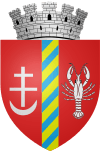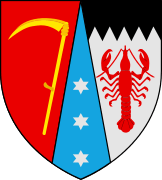Dorohoi
| Dorohoi | ||
|---|---|---|
| Municipality | ||
|
Wooden church in Dorohoi | ||
| ||
 Dorohoi Location of Dorohoi | ||
| Coordinates: 47°57′35″N 26°23′59″E / 47.95972°N 26.39972°ECoordinates: 47°57′35″N 26°23′59″E / 47.95972°N 26.39972°E | ||
| Country |
| |
| County | Botoşani County | |
| Status | Municipality | |
| Government | ||
| • Mayor | Dorin Alexandrescu (Social Democrat Party) | |
| Area | ||
| • Total | 60.39 km2 (23.32 sq mi) | |
| Population (2002) | ||
| • Total | 31,073 | |
| Time zone | EET (UTC+2) | |
| • Summer (DST) | EEST (UTC+3) | |
| Website | http://www.primariadorohoi.ro | |
Dorohoi (Romanian pronunciation: [doroˈhoj]) is a city in the Botoşani County, Romania, on the right bank of the Jijia River, which broadens into a lake on the north.
History
Dorohoi used to be a market for the timber and farm produce of the north Moldavian highlands; merchants from the neighboring states flocked to its great fair, held on the June 12. The settlement is first mentioned in documents from 1408, where a treaty was signed between Moldavian voievode, Alexandru cel Bun, and the King of Poland and Hungary. This suggests that the role of Dorohoi as a commercial center existed long before the founding of the Moldavian state.
Dorohoi was bombed by the Russians during World War I.[1]
Dorohoi used to be the capital of Dorohoi County, but was degraded to a municipality when Romania lost Northern Bukovina to the Soviet Union. On July 1, 1940, units of the Romanian Army attacked local Jews in a pogrom. These military actions against the Jews were not endorsed by the Romanian Government. When the conspiracy against the Jews was discovered by the military command, troops were sent to end the abuse.[2]
Geography
2010 Romanian floods
The northeastern town of Dorohoi witnessed deaths during the night of June 28–29 as floods rose to just over 1 metre/3.3 feet in some places. Several roads into Dorohoi remained either washed away or under water.[3] The heavy rain that had been falling for close to a week had forecasters warning that it would continue in northeast Romania.[3] The unusually heavy rain killed 6 people, most in the town of Dorohoi on the 29th.[4]
Demographics
| Historical population | ||
|---|---|---|
| Year | Pop. | ±% |
| 1900 | 12,701 | — |
| 1912 | 13,951 | +9.8% |
| 1930 | 15,866 | +13.7% |
| 1948 | 15,036 | −5.2% |
| 1956 | 14,771 | −1.8% |
| 1966 | 16,699 | +13.1% |
| 1977 | 22,161 | +32.7% |
| 1992 | 33,739 | +52.2% |
| 2002 | 31,073 | −7.9% |
| 2011 | 22,600 | −27.3% |
| Source: Census data | ||
According to the census from 2011 there was a total population of 22,600 people living in this city. Of this population, 98.13% are ethnic Romanians, 1.54% ethnic Romani, 0.07% ethnic Jews and 0.02% ethnic Ukrainians.[5]
Jews of Dorohoi
Jews first settled in Dorohoi in the 17th Century. It was set up as a Jewish Guild under Moldavia. Jews suffered here during World War I.
- There were 600 Jewish families in Dorohoi in 1803.
- 3,031 people in 1859 (roughly half of the population)
- 6,804 in 1899 (more than half of the population)
- 5,800 in 1930s.
The Jewish population actually increased after the Holocaust as a result of refugees settling there. In 1947, there were 7,600 Jews living in Dorohoi. Following the establishment of Israel, the Jewish population of the Dorohoi steadily decreased. In 1956, there were 2,753 Jews. In 1966, there were 1,013. By 2000, there were only 49 Jews left in Dorohoi.
Attractions
In the city there is a church built by Ştefan cel Mare.
Government
The city administers three villages: Dealu Mare, Loturi Enescu and Progresul.
References
- ↑ Stoica, Vasile (1919). The Roumanian Question: The Roumanians and their Lands. Pittsburgh: Pittsburgh Printing Company. p. 88.
- ↑ The Dorohoi Pogrom
- 1 2 Romania floods kill 21 - Hindustan Times
- ↑ 10 dead in Romanian floods | Online news | New Civil Engineer
- ↑ http://www.edrc.ro/recensamant.jsp?regiune_id=1&judet_id=90&localitate_id=92
External links
| Wikimedia Commons has media related to Dorohoi. |
- (Romanian) Official website
- Jewish Dorohoi

